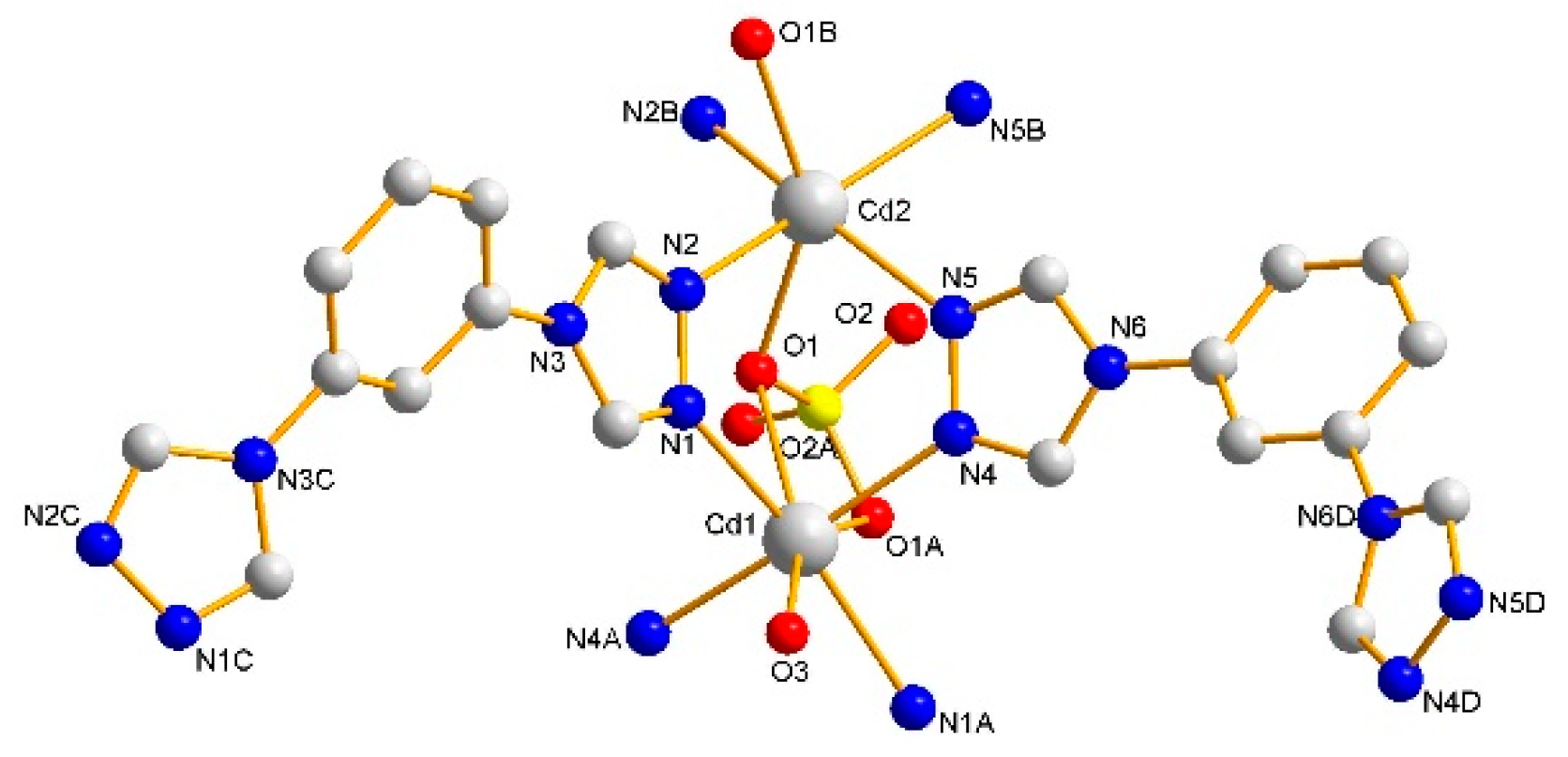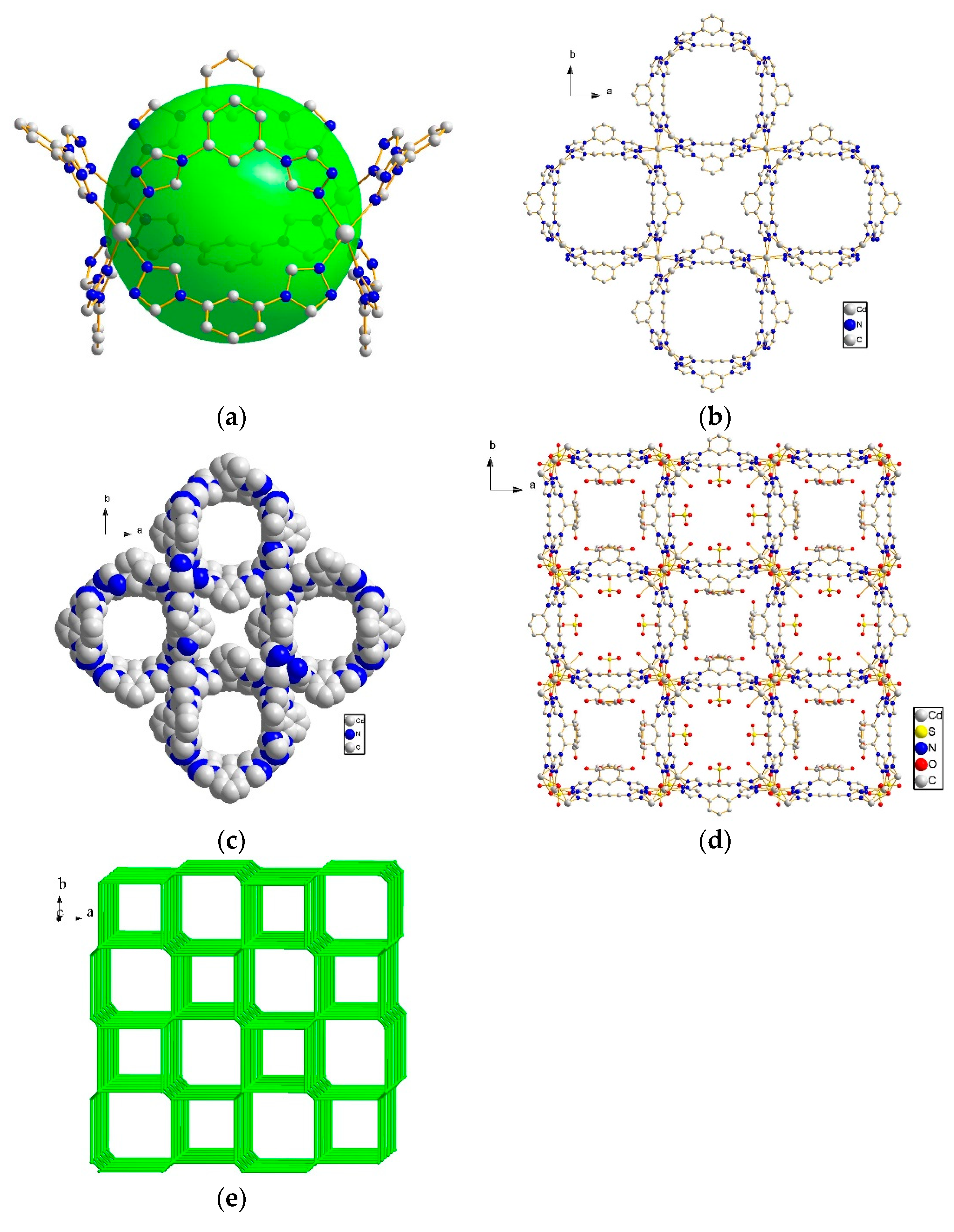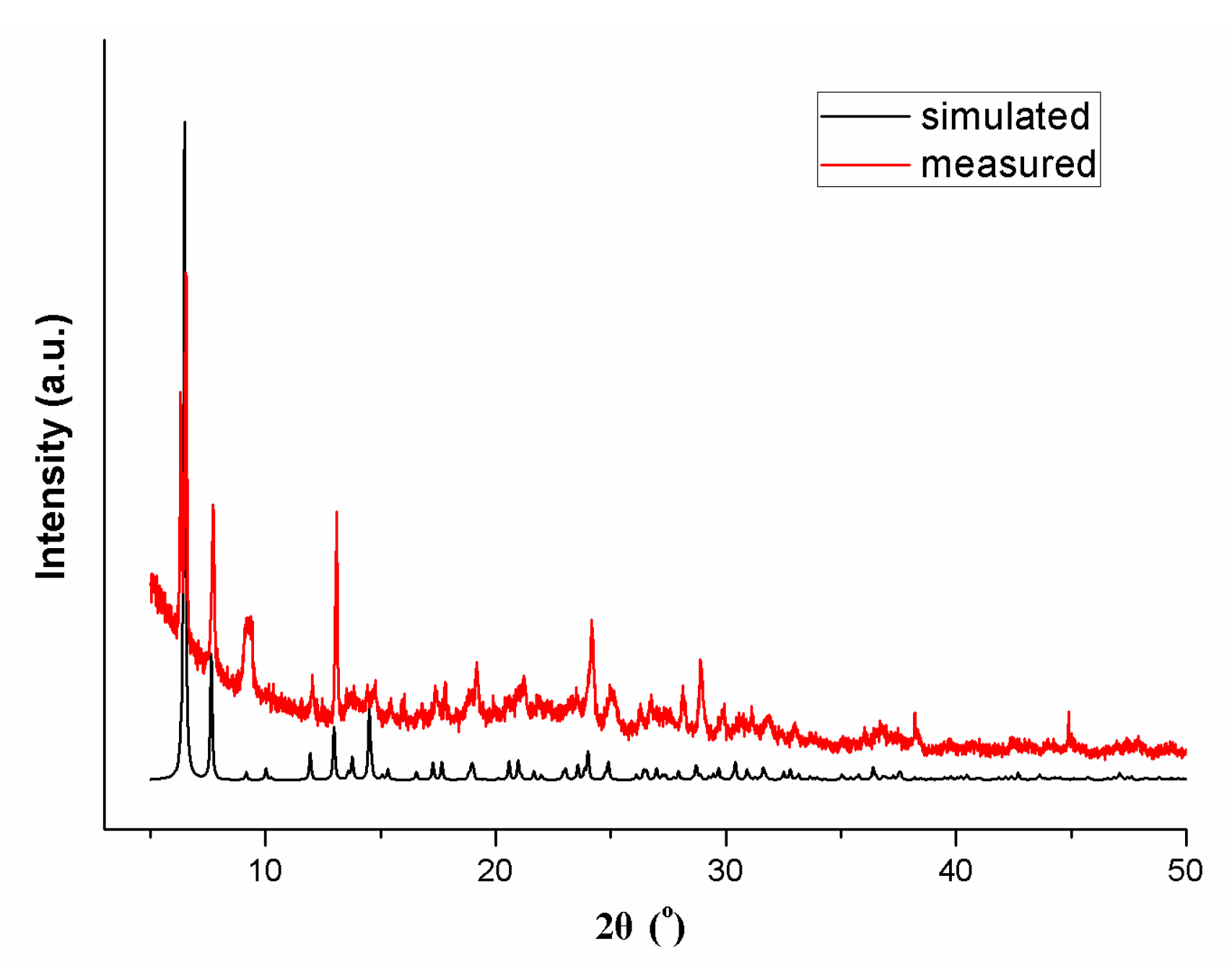A Three-Dimensional Cadmium(II) Coordination Network Based on 1,3-Di-(1,2,4-triazole-4-yl)benzene: Synthesis, Structure, and Luminescence Properties
Abstract
:1. Introduction
2. Materials and Methods
2.1. Reagents and Instruments
2.2. Single-Crystal X-ray Diffraction
2.3. Preparation of Compounds 1
3. Results and Discussion
3.1. Structural Description
3.2. Powder X-ray Diffraction (PXRD) and Thermal Analysis
3.3. Luminescent Properties
4. Conclusions
Supplementary Materials
Author Contributions
Acknowledgments
Conflicts of Interest
References
- Li, M.; Li, D.; O’Keeffe, M.; Yaghi, O.M. Topological analysis of metal-organic frameworks with polytopic linkers and/or multiple building units and the minimal transitivity principle. Chem. Rev. 2014, 114, 1343–1370. [Google Scholar] [CrossRef] [PubMed]
- Huang, Y.B.; Liang, J.; Wang, X.S.; Cao, R. Multifunctional metal-organic framework catalysts: Synergistic catalysis and tandem reactions. Chem. Soc. Rev. 2017, 46, 126–157. [Google Scholar] [CrossRef] [PubMed]
- Murray, L.J.; Dincă, M.; Long, J.R. Hydrogen storage in metal-organic frameworks. Chem. Soc. Rev. 2009, 38, 1294–1314. [Google Scholar] [CrossRef] [PubMed]
- Li, J.R.; Sculley, J.; Zhou, H.C. Metal-organic frameworks for separations. Chem. Rev. 2012, 112, 869–932. [Google Scholar] [CrossRef] [PubMed]
- Jia, Q.X.; Tian, H.; Zhang, J.Y.; Gao, E.Q. Diverse structures and magnetism of cobalt(II) and manganese(II) compounds with mixed azido and carboxylato bridges induced by methylpyridinium carboxylates. Chem. Eur. J. 2011, 38, 1330–1352. [Google Scholar] [CrossRef] [PubMed]
- Allendorf, M.D.; Bauer, C.A.; Bhakta, R.K.; Houk, R.J.T. Luminescent metal-organic frameworks. Chem. Soc. Rev. 2009, 14, 2781–2804. [Google Scholar] [CrossRef] [PubMed]
- Lu, Z.Z.; Zhang, R.; Li, Y.Z.; Guo, Z.J.; Zheng, H.G. Solvatochromic behavior of a nanotubular metal-organic framework for sensing small molecules. J. Am. Chem. Soc. 2011, 133, 4172–4174. [Google Scholar] [CrossRef] [PubMed]
- Zhang, M.; Feng, G.; Song, Z.; Zhou, Y.P.; Chao, H.Y.; Yuan, D.; Tan, T.T.Y.; Guo, Z.; Hu, Z.; Tang, B.Z.; et al. Two-dimensional metal-organic framework with wide channels and responsive turn-on fluorescence for chemical sensing of volatile organic compounds. J. Am. Chem. Soc. 2014, 136, 7241–7244. [Google Scholar] [CrossRef] [PubMed]
- Ma, D.; Li, B.; Zhou, X.; Zhou, Q.; Liu, K.; Zeng, G.; Li, G.; Shi, Z.; Feng, S. A dual functional MOF as a luminescent sensor for quantitatively detecting the concentration of nitrobenzene and temperature. Chem. Commun. 2013, 49, 8964–8966. [Google Scholar] [CrossRef] [PubMed]
- Stock, N.; Biswas, S. Synthesis of Metal-organic frameworks (MOFs): Routes to various MOF topologies, morphologies and composites. Chem. Rev. 2012, 112, 933–969. [Google Scholar] [CrossRef] [PubMed]
- Wang, L.; Yang, M.; Li, G.; Shi, Z.; Feng, S. Highly stable chiral cadmium 1,2,4-benzenetricarboxylate: Synthesis, structure, and NLO and fluorescence properties. Inorg. Chem. 2006, 45, 2474–2478. [Google Scholar] [CrossRef] [PubMed]
- Sun, D.; Collins, D.J.; Ke, Y.; Zuo, J.L.; Zhou, H.C. Construction of open metal-organic frameworks based on predesigned carboxylate isomers: From achiral to chiral nets. Chem. Eur. J. 2006, 12, 3768–3776. [Google Scholar] [CrossRef] [PubMed]
- Hu, Y.; Ding, M.; Liu, X.Q.; Sun, L.B.; Jiang, H.L. Rational synthesis of an exceptionally stable Zn(II) metal-organic framework for the highly selective and sensitive detection of picric acid. Chem. Commun. 2016, 52, 5734–5737. [Google Scholar] [CrossRef] [PubMed]
- Noro, S.; Kitagawa, S.; Akutagawa, T.; Nakamura, T. Coordination polymers constructed from transition metal ions and organic N-containing heterocyclic ligands: Crystal structures and microporous properties. Prog. Polym. Sci. 2009, 34, 240–279. [Google Scholar] [CrossRef]
- Guo, J.; Sun, D.; Zhang, L.; Yang, Q.; Zhao, X.; Sun, D. Cadmium-organic coordination polymers based on N-donor ligands and small anions: Syntheses, crystal structures, and photoluminescent properties. Cryst. Growth Des. 2012, 12, 5649–5654. [Google Scholar] [CrossRef]
- Nikolaeva, Y.A.; Balueva, A.S.; Khafizov, A.A.; Strelnik, I.D.; Gerasimova, T.P.; Katsyuba, S.A.; Litvinov, I.A.; Musina, E.I.; Karasik, A.A.; Sinyashin, O.G. The first representatives of tetranuclear gold(I) complexes of P,N-containing cyclophanes. Dalton Trans. 2018, 47, 7715–7720. [Google Scholar] [CrossRef] [PubMed]
- Hao, J.; Yu, B.; Hecke, K.V.; Cui, G. A series of d10 metal coordination polymers based on a flexible bis(2-methylbenzimidazol) ligand and different carboxylates: Synthesis, structures, photoluminescence and catalytic properties. CrystEngComm. 2015, 17, 2279–2293. [Google Scholar] [CrossRef]
- Zhou, X.; Liu, D.; Lang, F.F.; Ren, Z.G.; Lang, J.P. Two 2D zinc(II) coordination polymers and their orange IV composites: Preparation, structures, and photocurrent responses. Cryst. Growth Des. 2019, 19, 211–218. [Google Scholar] [CrossRef]
- Rachuri, Y.; Parmar, B.; Bisht, K.K.; Suresh, E. Mixed ligand two dimensional Cd(II)/Ni(II) metal organic frameworks containing dicarboxylate and tripodal N-donor ligands: Cd(II) MOF is an efficient luminescent sensor for detection of picric acid in aqueous media. Dalton Trans. 2016, 45, 7881–7892. [Google Scholar] [CrossRef] [PubMed]
- Li, Z.H.; He, S.J.; Xue, L.P.; Wang, X.N.; Zhang, D.D.; Zhao, B.T. Exploring methyl-3-hydroxy-5-carboxy-2-thiophenecarboxylate and varying flexible bis(imidazole)-based synthons as building blocks for the construction of diverse cadmium coordination polymers. Dye Pigments. 2018, 149, 498–504. [Google Scholar] [CrossRef]
- Aromi, G.; Barrios, L.A.; Roubeau, O.; Gamez, P. Triazoles and tetrazoles: Prime ligands to generate remarkable coordination materials. Coord. Chem. Rev. 2011, 255, 485–546. [Google Scholar] [CrossRef]
- Yi, L.; Ding, B.; Zhao, B.; Cheng, P.; Liao, D.Z.; Yan, S.P.; Jiang, Z.H. Novel triazole-bridged cadmium coordination polymers varying from zero- to three-dimensionality. Inorg. Chem. 2004, 43, 33–43. [Google Scholar] [CrossRef] [PubMed]
- Hu, Y.J.; Yang, J.; Liu, Y.Y.; Song, S.; Ma, J.F. Hierarchical symmetry transfer and flexible charge matching in five [M(phen)3]2+ directed iodoargentates with 1 to 3D frameworks. Cryst. Growth Des. 2015, 15, 3822–3831. [Google Scholar] [CrossRef]
- Zhang, S.H.; Wang, J.M.; Zhang, H.Y.; Fan, Y.P.; Xiao, Y. Highly efficient electrochemiluminescence based on 4-amino-1,2,4-triazoles Schiff base two-dimensional Zn/Cd coordination polymers. Dalton Trans. 2017, 46, 410–419. [Google Scholar] [CrossRef] [PubMed]
- Miao, S.B.; Li, Z.H.; Xu, C.Y.; Ji, B.M. Syntheses, characterization, and luminescence properties of three novel Ag(I) coordination polymers based on polycarboxylic acid ligands and 1,3-di-(1,2,4-triazole-4-yl)benzene. CrystEngComm. 2016, 18, 4636–4642. [Google Scholar] [CrossRef]
- Miao, S.B.; Li, Z.H.; Xu, C.Y.; Ji, B.M. A new 3-fold interpenetrating 3D Zn(II) metal-organic framework: Synthesis, structure and luminescent property. Chin. J. Struct. Chem. 2016, 35, 1960–1966. [Google Scholar]
- Miao, S.B.; Xu, C.Y.; Deng, D.S.; Ji, B.M. Synthesis, crystal structure, and properties of a 2D Cu(II) coordination polymer based on Cu3I3 chains linked by 1,3-di-(1,2,4-triazole-4-yl)benzene. J. Clust. Sci. 2018, 29, 313–317. [Google Scholar] [CrossRef]
- Yang, P.; Wu, X.X.; Huo, J.Z.; Ding, B.; Wang, Y.; Wang, X.G. Hydrothermal synthesis and characterization of a series of luminescent Zn(II) and Cd(II) coordination polymers with the new versatile multidentate ligand 1,3-di-(1,2,4-triazole-4-yl)benzene. CrystEngComm. 2013, 15, 8097–8109. [Google Scholar] [CrossRef]
- Dolomanov, O.V.; Bourhis, L.J.; Gildea, R.J.; Howard, J.A.K.; Puschmann, H. OLEX2: A complete structure solution, refinement and analysis program. J. Appl. Cryst. 2009, 42, 342–346. [Google Scholar] [CrossRef]
- Sheldrick, G.M. Crystal structure refinement with SHELXL. Acta Cryst. 2015, 71, 3–8. [Google Scholar]
- Ding, B.; Yang, P.; Liu, Y.Y.; Wang, Y.; Du, G.X. Hydrothermal syntheses and characterization of a series of luminescent Cd(II) frameworks with pyridine-based and benzene-based bis-triazole ligands. CrystEngComm 2013, 15, 2490–2503. [Google Scholar] [CrossRef]





| Compound | 1 |
|---|---|
| Empirical formula | C28H24N12O13S2Cd2 |
| Formula mass | 1025.51 |
| Crystal system | tetragonal |
| space group | I-4m2 |
| a/Å | 27.274(5) |
| b/Å | 27.274(5) |
| c/Å | 12.763(5) |
| V/Å3, Z | 9494(5), 8 |
| Dc (g cm−3) | 1.435 |
| μ/mm−1 | 1.05 |
| F(000) | 4064 |
| Reflections collected/unique | 36253/4618 |
| Data/restraints/parameters | 4618/3/272 |
| GOF(F2) | 1.072 |
| R1/wR2 [I > 2σ(I)] | 0.0449/0.1458 |
| R1/wR2 (all data) | 0.0470/0.1484 |
© 2019 by the authors. Licensee MDPI, Basel, Switzerland. This article is an open access article distributed under the terms and conditions of the Creative Commons Attribution (CC BY) license (http://creativecommons.org/licenses/by/4.0/).
Share and Cite
Miao, S.; Li, Z.; Xu, C.; Deng, D.; Ji, B. A Three-Dimensional Cadmium(II) Coordination Network Based on 1,3-Di-(1,2,4-triazole-4-yl)benzene: Synthesis, Structure, and Luminescence Properties. Crystals 2019, 9, 592. https://doi.org/10.3390/cryst9110592
Miao S, Li Z, Xu C, Deng D, Ji B. A Three-Dimensional Cadmium(II) Coordination Network Based on 1,3-Di-(1,2,4-triazole-4-yl)benzene: Synthesis, Structure, and Luminescence Properties. Crystals. 2019; 9(11):592. https://doi.org/10.3390/cryst9110592
Chicago/Turabian StyleMiao, Shaobin, Zhaohao Li, Chunying Xu, Dongsheng Deng, and Baoming Ji. 2019. "A Three-Dimensional Cadmium(II) Coordination Network Based on 1,3-Di-(1,2,4-triazole-4-yl)benzene: Synthesis, Structure, and Luminescence Properties" Crystals 9, no. 11: 592. https://doi.org/10.3390/cryst9110592
APA StyleMiao, S., Li, Z., Xu, C., Deng, D., & Ji, B. (2019). A Three-Dimensional Cadmium(II) Coordination Network Based on 1,3-Di-(1,2,4-triazole-4-yl)benzene: Synthesis, Structure, and Luminescence Properties. Crystals, 9(11), 592. https://doi.org/10.3390/cryst9110592




